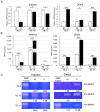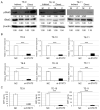Matrix Metalloproteinase 9 Induced in Esophageal Squamous Cell Carcinoma Cells via Close Contact with Tumor-Associated Macrophages Contributes to Cancer Progression and Poor Prognosis
- PMID: 37296952
- PMCID: PMC10252039
- DOI: 10.3390/cancers15112987
Matrix Metalloproteinase 9 Induced in Esophageal Squamous Cell Carcinoma Cells via Close Contact with Tumor-Associated Macrophages Contributes to Cancer Progression and Poor Prognosis
Abstract
Tumor-associated macrophages (TAMs) contribute to disease progression in various cancers, including esophageal squamous cell carcinoma (ESCC). We have previously used an indirect co-culture system between ESCC cell lines and macrophages to analyze their interactions. Recently, we established a direct co-culture system to closely simulate actual ESCC cell-TAM contact. We found that matrix metalloproteinase 9 (MMP9) was induced in ESCC cells by direct co-culture with TAMs, not by indirect co-culture. MMP9 was associated with ESCC cell migration and invasion, and its expression was controlled by the Stat3 signaling pathway in vitro. Immunohistochemical analyses revealed that MMP9 expression in cancer cells at the invasive front ("cancer cell MMP9") was related to high infiltration of CD204 positive M2-like TAMs (p < 0.001) and was associated with worse overall and disease-free survival of patients (p = 0.036 and p = 0.038, respectively). Furthermore, cancer cell MMP9 was an independent prognostic factor for disease-free survival. Notably, MMP9 expression in cancer stroma was not associated with any clinicopathological factors or patient prognoses. Our results suggest that close interaction with TAMs infiltrating in cancer stroma or cancer nests induces MMP9 expression in ESCC cells, equipping them with more malignant features.
Keywords: activator of transcription 3; direct co-culture; direct contact; esophageal squamous cell carcinoma; immunohistochemistry; interleukin-8; matrix metalloproteinase 9; prognostic factor; signal transducer; tumor-associated macrophage.
Conflict of interest statement
The authors declare no conflict of interest.
Figures







Similar articles
-
CCL3-CCR5 axis contributes to progression of esophageal squamous cell carcinoma by promoting cell migration and invasion via Akt and ERK pathways.Lab Invest. 2020 Sep;100(9):1140-1157. doi: 10.1038/s41374-020-0441-4. Epub 2020 May 26. Lab Invest. 2020. PMID: 32457351 Free PMC article.
-
CD163 as a marker of M2 macrophage, contribute to predicte aggressiveness and prognosis of Kazakh esophageal squamous cell carcinoma.Oncotarget. 2017 Mar 28;8(13):21526-21538. doi: 10.18632/oncotarget.15630. Oncotarget. 2017. PMID: 28423526 Free PMC article.
-
ANXA10 induction by interaction with tumor-associated macrophages promotes the growth of esophageal squamous cell carcinoma.Pathol Int. 2019 Mar;69(3):135-147. doi: 10.1111/pin.12771. Epub 2019 Feb 13. Pathol Int. 2019. PMID: 30758105 Free PMC article.
-
Roles of IL-7R Induced by Interactions between Cancer Cells and Macrophages in the Progression of Esophageal Squamous Cell Carcinoma.Cancers (Basel). 2023 Jan 6;15(2):394. doi: 10.3390/cancers15020394. Cancers (Basel). 2023. PMID: 36672342 Free PMC article.
-
CXCL8 derived from tumor-associated macrophages and esophageal squamous cell carcinomas contributes to tumor progression by promoting migration and invasion of cancer cells.Oncotarget. 2017 Nov 20;8(62):106071-106088. doi: 10.18632/oncotarget.22526. eCollection 2017 Dec 1. Oncotarget. 2017. PMID: 29285315 Free PMC article.
Cited by
-
Attenuated Salmonella typhimurium L forms suppress tumor growth and promote apoptosis in murine ovarian tumors.Sci Rep. 2024 Jul 11;14(1):16045. doi: 10.1038/s41598-024-66898-x. Sci Rep. 2024. PMID: 38992056 Free PMC article.
-
Single-cell RNA sequencing reveals different cellular states in malignant cells and the tumor microenvironment in primary and metastatic ER-positive breast cancer.NPJ Breast Cancer. 2025 Aug 26;11(1):95. doi: 10.1038/s41523-025-00808-w. NPJ Breast Cancer. 2025. PMID: 40858590 Free PMC article.
-
Biological implications of decoding the extracellular matrix of vulva cancer.Oncol Rep. 2025 Feb;53(2):19. doi: 10.3892/or.2024.8852. Epub 2024 Dec 13. Oncol Rep. 2025. PMID: 39670289 Free PMC article. Review.
-
IFI16 Induced by Direct Interaction between Esophageal Squamous Cell Carcinomas and Macrophages Promotes Tumor Progression via Secretion of IL-1α.Cells. 2023 Nov 10;12(22):2603. doi: 10.3390/cells12222603. Cells. 2023. PMID: 37998338 Free PMC article.
-
Evaluating Potential Therapeutic Targets and Drug Repurposing Based on the Esophageal Cancer Subtypes.Pharmaceuticals (Basel). 2025 Aug 11;18(8):1181. doi: 10.3390/ph18081181. Pharmaceuticals (Basel). 2025. PMID: 40872572 Free PMC article.
References
-
- Cancer Statistics Cancer Information Service, National Cancer Center, Japan (National Cancer Registry, Ministry of Health, Labour and Welfare) [(accessed on 24 February 2023)]. Available online: https://ganjoho.jp/reg_stat/statistics/data/dl/index.html#a14.
-
- Shimada H., Nabeya Y., Okazumi S.-I., Matsubara H., Shiratori T., Gunji Y., Kobayashi S., Hayashi H., Ochiai T. Prediction of survival with squamous cell carcinoma antigen in patients with resectable esophageal squamous cell carcinoma. Surgery. 2003;133:486–494. doi: 10.1067/msy.2003.139. - DOI - PubMed
Grants and funding
LinkOut - more resources
Full Text Sources
Research Materials
Miscellaneous

